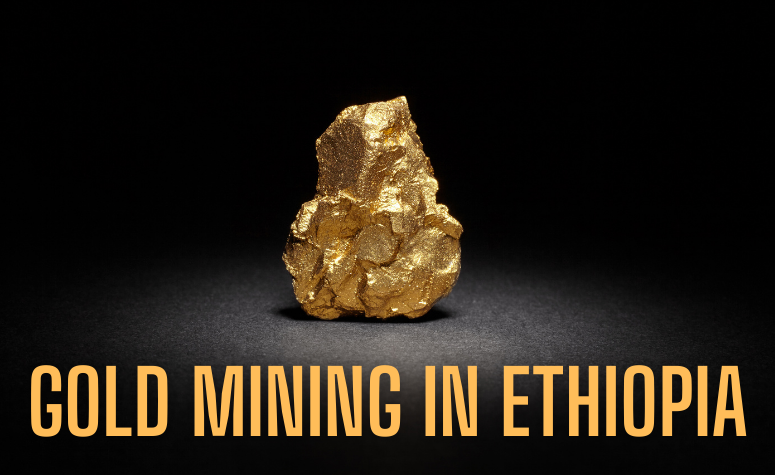
As the legends go, Ethiopia was the origin of the gold treasures of the legendary Queen of Sheba. Ancient Ethiopia or Abyssinia exported gold to Egyptian empires, and today its gold goes to the biggest gold markets in the world.
There’s no question that Ethiopia has been the source of gold and precious metals for millennia. But what goes on today? Let’s take a quick dive into the gold mining history and modern mining in Ethiopia.
The earliest records of gold mining in Ethiopia
Though archeological and geological records of gold mining in Ethiopia go back thousands of years, the best-known historical accounts are from the 16th century by Portuguese and other European writers.
In western Ethiopia, the Asosa region, in particular, was significant for most artisanal (traditional) and small-scale mining. There are plenty of mountain ridges, streams, and rivers still being worked by locals for gold in this region. After the invasion, Italians explored these western lowlands of Ethiopia but couldn’t carry out large-scale mining. The Ethiopian emperors also made an effort to start large-scale mining in the area. However, it still stands in the beginning phase, and only limited artisanal mining is done here.
In southern Ethiopia, the Adola belt, in particular, is known for its gold mining activities. According to reports of EMRDC (Ethiopian Mineral Resources Development Corporation), more than 55 tons of gold were produced in the Adola belt between 1936 to 1996, and this only includes the official reported figures. The gold veins here are part of the Arabian Nubian gold shield, one of Africa’s biggest gold belts. Ethiopia’s two significant gold deposits, Lega Dembi and Sakaro, are in this region.

Current Production and Gold Mines in Ethiopia
Lega Dambi:
In 1975, gold prospectors found two hard rock gold reserves in Sakaro and Demi Dama in the Adola Belt. Ethiopian Mining Corporation led an extensive exploration of the region over the next few years. Eventually, favorable results prompted the opening of Ethiopia’s first modern gold opens pit mine in Lega Dembi. At the time it was run by government-owned EMRDC, the mine was sold to a Saudi gold mining company MIDROC Gold, for $172 million in 1997.
MIDROC turned it into an underground mine, and at its peak, Lega Dambi was producing around four tons of gold per year. However, the company reported that the mine was no longer profitable in 2018 and closed the operation.
Sakara:
The Sakara mines are located just a few miles from the Lega Dembi and are situated in the same gold belt. However, Sakara gold operations consist of many open pits and underground tunnels rather than one modern mine.
The government corporation, EMDRC, started the alluvial and eluvial here in 1986. Until 1991, Sakara produced about 895.7 kg of gold. MIDROC commenced its exploration in Sakara in 2009 and opened an underground pit to reach deeper deposits. At the end of 2012, MIDROC reported it had produced five tons of gold each year. MIDROC was granted a ten-year contract by the Ethiopian government, but it was terminated early in 2018 due to environmental concerns.

Other gold mines:
Several new gold mines are currently under development in Ethiopia.
A leading American gold mining company, Newmont, is undertaking a large-scale gold mine in Tigray.
KEFI Minerals, a UK firm, is developing a gold mine in the South-Western Oromia region.
MIDROC Gold has reached an agreement to establish a new gold mine in the Metekel Zone of the Benishangul Gumuz.
Ethiopia’s gold production in recent years:
Ethiopia’s annual gold production has been in a steep decline since 2013. The country’s gold production fell from 12 tons of gold in 2013 to less than 4 tons in 2018.
Interestingly, since the covid 19 pandemic, artisanal gold mining has boomed in Ethiopia. While the global job markets remain under pressure, Ethiopians have found employment through gold mining. In 2020, Ethiopia produced 6.6 tons of gold, bringing in 505 million US Dollars in gold sales. Ethiopia has significant potential to increase the volume of its gold production, and after the new gold mines open, the country’s gold output is expected to increase significantly.
What future holds for Ethiopia?
Ethiopia’s mining companies export their gold to Swiss refineries, and the National Bank collects only minor produce, which comes from small-scale miners. Ethiopia’s gold economy is thus far largely reliant on small-scale miners, who are losing a lot to middlemen.
As a result, illegal trade and smuggling are rampant, and the government is apparently unable to control it. The harsh environmental impacts of gold mining are also a cause for concern. The current government has promised to take the industry towards a cleaner and more transparent business model.
